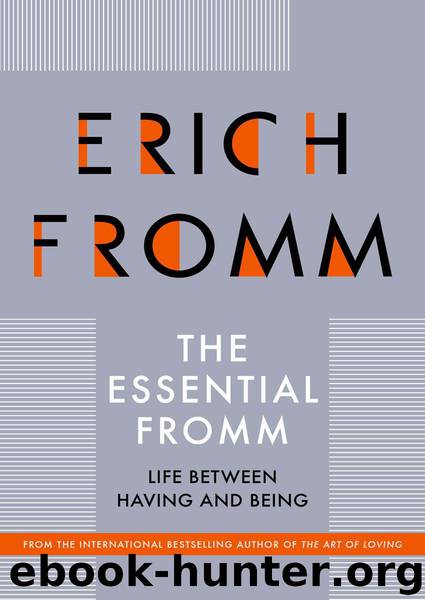The Essential Fromm: Life Between Having and Being by Erich Fromm

Author:Erich Fromm [Fromm, Erich]
Language: eng
Format: epub
ISBN: 9781504008266
Publisher: Open Road Distribution
Published: 2014-12-08T20:00:00+00:00
Busyness (as a Compensation of Passiveness) versus Productive Activity
[That activity corresponds with the being mode but passivity is typical for the having mode of existence] is confusing for the modern mind because in our usage activity is usually defined as behavior that brings about a change in an existing situation by an expenditure of energy; it is synonymous with being “busy.” In contrast, a person is described as passive if he is unable to change or overtly influence an existing situation by an expenditure of energy and is influenced or moved by forces outside himself. This current concept of activity takes into account only the actual expenditure of energy and the change brought about by it. It does not distinguish between the underlying psychic conditions governing the activities.
An example, though an extreme one, of nonproductive “activity” is the activity of a person under hypnosis. The person in a deep hypnotic trance may have his eyes open, may walk, talk, and do things; he “acts.” The general definition of activity would apply to him, since energy is spent and some change brought about. But if we consider the particular character and quality of this activity, we find that it is not really the hypnotized person who is the actor, but the hypnotist, who, by means of his suggestions, acts through him. While the hypnotic trance is an artificial state, it is an extreme but characteristic example of a situation in which a person can be active and yet not be the true actor, since his activity results from compelling forces over which he has no control.
Social Character in a Mexican Village, p. 73.
Activity in the modern sense refers only to behavior, not to the person behind the behavior. It makes no difference whether people are active because they are driven by external force, like a slave, or by internal compulsion, like a person driven by anxiety. It does not matter whether they are interested in their work, like a carpenter or a creative writer, or a scientist or a gardener; or whether they have no inner relation to and satisfaction in what they are doing, like the worker on the assembly line or the postal clerk.
The modern sense of activity makes no distinction between activity and mere busyness. But there is a fundamental difference between the two that corresponds to the terms “alienated” and “non-alienated” in respect to activities. In alienated activity I do not experience myself as the acting subject of my activity; rather, I experience the outcome of my activity—and that as something “over there,” separated from me and standing above and against me. In alienated activity I do not really act; I am acted upon by external or internal forces. I have become separated from the result of my activity. The best observable case of alienated activity in the field of psychopathology is that of compulsive-obsessional persons. Forced by an inner urge to do something against their own wills—such as counting steps, repeating certain phrases, performing certain private
Download
This site does not store any files on its server. We only index and link to content provided by other sites. Please contact the content providers to delete copyright contents if any and email us, we'll remove relevant links or contents immediately.
Rewire Your Anxious Brain by Catherine M. Pittman(18496)
Talking to Strangers by Malcolm Gladwell(13141)
The Art of Thinking Clearly by Rolf Dobelli(10149)
Mindhunter: Inside the FBI's Elite Serial Crime Unit by John E. Douglas & Mark Olshaker(9112)
Becoming Supernatural by Dr. Joe Dispenza(8046)
Change Your Questions, Change Your Life by Marilee Adams(7574)
The Road Less Traveled by M. Scott Peck(7480)
Nudge - Improving Decisions about Health, Wealth, and Happiness by Thaler Sunstein(7469)
The Lost Art of Listening by Michael P. Nichols(7365)
Mastermind: How to Think Like Sherlock Holmes by Maria Konnikova(7171)
Enlightenment Now: The Case for Reason, Science, Humanism, and Progress by Steven Pinker(7091)
Win Bigly by Scott Adams(7039)
The Way of Zen by Alan W. Watts(6459)
Daring Greatly by Brene Brown(6374)
Big Magic: Creative Living Beyond Fear by Elizabeth Gilbert(5562)
Grit by Angela Duckworth(5455)
Ego Is the Enemy by Ryan Holiday(5235)
Men In Love by Nancy Friday(5121)
Altered Sensations by David Pantalony(5013)
